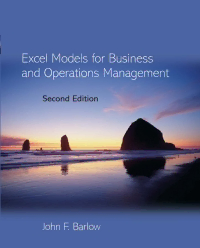Download Excel Models for Business and Operations Management PDF Free - Full Version
Download Excel Models for Business and Operations Management by John Barlow in PDF format completely FREE. No registration required, no payment needed. Get instant access to this valuable resource on PDFdrive.to!
About Excel Models for Business and Operations Management
<i>Excel Models for Business and Operations Management, Second Edition</i>, adopts a structured approach to management decision-making by integrating the activities of a manufacturing organization. The text is entirely assignment-based and uses Microsoft’s Excel software to develop over eighty models. Everyday examples from finance, marketing and operations management form the basis of the book’s ‘hands-on’ development models. As in the previous edition, the emphasis is on the practical implementation of real-world models rather than traditional theoretical concepts. The book’s learn-by-example approach helps to develop both analytical and mathematical skills by focusing on the formulation and building of business models. <p>New features in the second edition include</p> <ul> <li>Finance models in a new chapter on investment analysis models</li> <li>Job sequencing including a VBA routine for Johnson’s Rule</li> <li>Multiplicative Holt-Winter’s model</li> <li>All models and reference notes updated to the latest version of Excel</li> </ul> <p><i>Excel Models for Business and Operations Management</i> is ideally suited to intermediate and advanced undergraduate courses, as well as MBA courses, in business studies, finance, accounting, information technology, and operations management. It should be of interest to managers and analysts who want to develop their model-building skills.</p>
Detailed Information
| Author: | John Barlow |
|---|---|
| Publication Year: | 2005 |
| ISBN: | 9780470016350 |
| Language: | English |
| File Size: | 4.47 |
| Format: | |
| Price: | FREE |
Safe & Secure Download - No registration required
Why Choose PDFdrive for Your Free Excel Models for Business and Operations Management Download?
- 100% Free: No hidden fees or subscriptions required for one book every day.
- No Registration: Immediate access is available without creating accounts for one book every day.
- Safe and Secure: Clean downloads without malware or viruses
- Multiple Formats: PDF, MOBI, Mpub,... optimized for all devices
- Educational Resource: Supporting knowledge sharing and learning
Frequently Asked Questions
Is it really free to download Excel Models for Business and Operations Management PDF?
Yes, on https://PDFdrive.to you can download Excel Models for Business and Operations Management by John Barlow completely free. We don't require any payment, subscription, or registration to access this PDF file. For 3 books every day.
How can I read Excel Models for Business and Operations Management on my mobile device?
After downloading Excel Models for Business and Operations Management PDF, you can open it with any PDF reader app on your phone or tablet. We recommend using Adobe Acrobat Reader, Apple Books, or Google Play Books for the best reading experience.
Is this the full version of Excel Models for Business and Operations Management?
Yes, this is the complete PDF version of Excel Models for Business and Operations Management by John Barlow. You will be able to read the entire content as in the printed version without missing any pages.
Is it legal to download Excel Models for Business and Operations Management PDF for free?
https://PDFdrive.to provides links to free educational resources available online. We do not store any files on our servers. Please be aware of copyright laws in your country before downloading.
The materials shared are intended for research, educational, and personal use in accordance with fair use principles.

